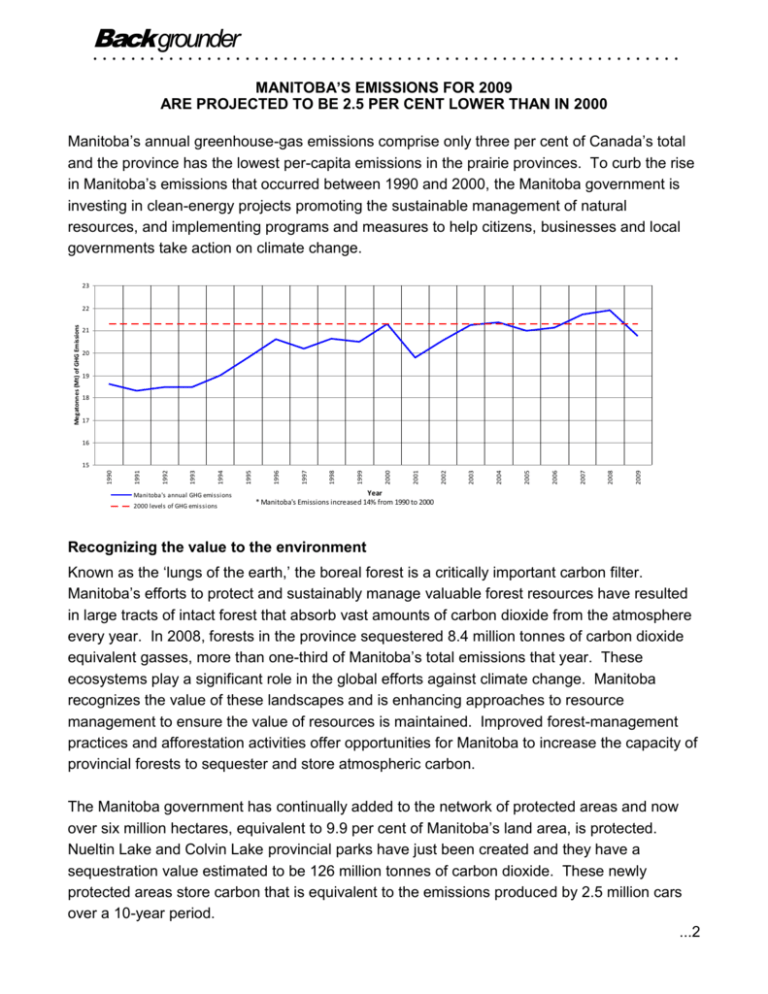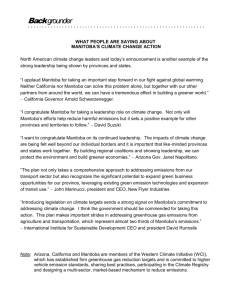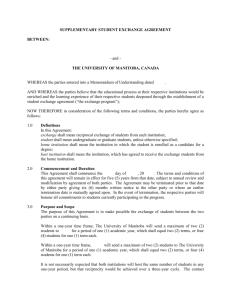Manitoba`s emissions - Government of Manitoba
advertisement

Back grounder • • • • • • • • • • • • • • • • • • • • • • • • • • • • • • • • • • • • • • • • • • • • • • • • • • • • • • • • • • • • • • MANITOBA’S EMISSIONS FOR 2009 ARE PROJECTED TO BE 2.5 PER CENT LOWER THAN IN 2000 Manitoba’s annual greenhouse-gas emissions comprise only three per cent of Canada’s total and the province has the lowest per-capita emissions in the prairie provinces. To curb the rise in Manitoba’s emissions that occurred between 1990 and 2000, the Manitoba government is investing in clean-energy projects promoting the sustainable management of natural resources, and implementing programs and measures to help citizens, businesses and local governments take action on climate change. 23 Megatonnes (Mt) of GHG Emissions 22 21 20 19 18 17 16 Manitoba's annual GHG emissions 2000 levels of GHG emissions 2009 2008 2007 2006 2005 2004 2003 2002 2001 2000 1999 1998 1997 1996 1995 1994 1993 1992 1991 1990 15 Year * Manitoba's Emissions increased 14% from 1990 to 2000 Recognizing the value to the environment Known as the ‘lungs of the earth,’ the boreal forest is a critically important carbon filter. Manitoba’s efforts to protect and sustainably manage valuable forest resources have resulted in large tracts of intact forest that absorb vast amounts of carbon dioxide from the atmosphere every year. In 2008, forests in the province sequestered 8.4 million tonnes of carbon dioxide equivalent gasses, more than one-third of Manitoba’s total emissions that year. These ecosystems play a significant role in the global efforts against climate change. Manitoba recognizes the value of these landscapes and is enhancing approaches to resource management to ensure the value of resources is maintained. Improved forest-management practices and afforestation activities offer opportunities for Manitoba to increase the capacity of provincial forests to sequester and store atmospheric carbon. The Manitoba government has continually added to the network of protected areas and now over six million hectares, equivalent to 9.9 per cent of Manitoba’s land area, is protected. Nueltin Lake and Colvin Lake provincial parks have just been created and they have a sequestration value estimated to be 126 million tonnes of carbon dioxide. These newly protected areas store carbon that is equivalent to the emissions produced by 2.5 million cars over a 10-year period. ...2 -2Manitoba is currently developing a Terrestrial Carbon Management Action Plan, which will increase scientific knowledge of terrestrial carbon cycles, promote stewardship of terrestrial carbon pools and incorporate an understanding of carbon sequestration into provincial climate-change policy. In 2008, the province committed to plant five million trees over five years through the Trees for Tomorrow program, which will sequester more than one million tonnes of carbon dioxide equivalent gases over the next 50 years. Approximately 2.5 million seedlings have been planted throughout the province to date. Investing in clean energy Manitoba’s contribution to climate protection extends well beyond the province’s borders. In 2009, Manitoba Hydro’s clean-energy exports displaced over seven million tonnes of emissions from coal and natural gas in other jurisdictions. These reductions represent twice Manitoba’s required Kyoto target. Manitoba is further expanding clean energy through hydro projects like the Wuskwatim Dam. Growing hydro production Manitoba already has 5,000 megawatts of hydroelectric generating capacity with the potential to double this amount. In partnership with local Aboriginal communities, several new projects are underway: the 200-megawatt Wuskwatim hydro project is currently under construction, and other generating stations are being developed to provide an additional 2,000 megawatts. Wind energy leaders A total of 63 wind turbines have been erected over a 93-square-kilometre area in St. Leon in southwestern Manitoba, which are capable of delivering 99 megawatts of clean power. Construction is moving forward on a 138-megawatt wind farm at St. Joseph, in south central Manitoba. With 60 wind turbines covering 125 square kilometres, St. Joseph is the largest wind farm scheduled to be built in Canada in 2010, generating enough power to meet the needs of 50,000 homes. Manitoba Hydro displaces greenhouse-gas emissions in other jurisdictions through its wind-energy exports. These are currently estimated at 260,000 tonnes annually from the 99-megawatt wind farm in St. Leon and are expected to grow by an additional 350,000 tonnes to a total of 610,000 tonnes annually following completion of the St. Joseph project. ...3 -3Geothermal energy leaders Manitobans are installing geothermal heating systems at more than three times the Canadian average on a per-capita basis. A geothermal system installed in a typical Manitoba home will reduce emissions by an average of five tonnes annually. Investing in energy efficiency Manitoba Hydro’s Power Smart energy conservation programs have already saved over 500 megawatts of electricity the equivalent of one entire hydro dam while removing approximately one million tonnes of greenhouse-gas emissions. As a result, Manitoba was awarded an A-plus in the Canadian Energy Efficiency Alliance’s national report card on energy efficiency. The province also recently announced new building codes, which will reduce carbon-dioxide emissions in an average home by more than one-half or about 1.25 tonnes per year. Phasing out coal The coal generating station in Selkirk has been converted to natural gas and Manitoba’s last remaining coal plant in Brandon has been phased down to be used for emergency purposes only, leading to greenhouse-gas reductions in excess of 350,000 tonnes. Biofuels are reducing emissions and reducing fuel imports Manitoba has an 8.5 per cent ethanol mandate in place and was the first province in Canada to mandate the use of biodiesel, diversifying the provincial economy and reducing emissions from the transportation sector. In 2010, Manitoba’s biofuels investments reduced greenhouse-gas emissions by over 360,000 tonnes. Managing landfill-gas emissions Manitoba’s landfill-gas capture programs will allow the province’s largest landfills to make significant reductions in the amount of greenhouse-gas emissions released. These projects are expected to achieve 150,000 tonnes of reductions per year in 2012.





